PRINCETON, NJ -- The Gallup Economic Confidence Index registered -47 for the week ending Nov. 6, down slightly from the -44 and -46 readings seen in the last two weeks of October. Still, confidence is running slightly higher than the exceptionally weak readings of -50 and worse that dominated the economic confidence picture from late July through early October.
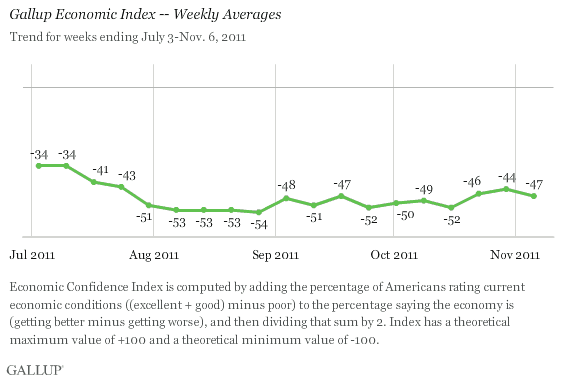
Consumers' Outlook Remains Worse Than Current Perceptions
The Gallup Economic Confidence Index is an average of two components of consumers' psychology: Americans' ratings of current economic conditions in the country and their perceptions of whether the U.S. economy is getting better or getting worse. Both dimensions are highly negative at present, similar to where they stood in late October. But the forecast dimension, at -50, continues to be slightly worse than the current conditions dimension, at -44.
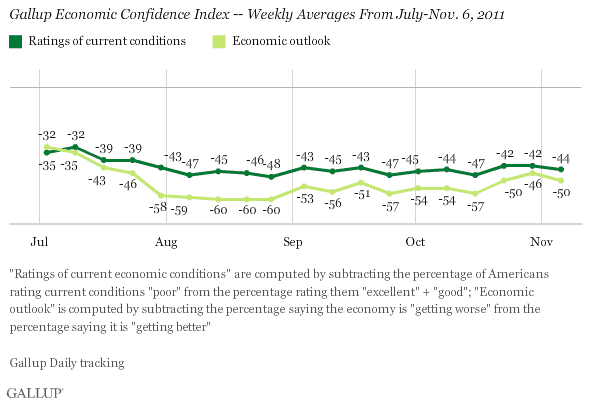
At almost all points from March 2009-July 2011, Americans' economic outlook matched or exceeded their perceptions of the current economy. Since then, the outlook dimension has been significantly lower than the current conditions dimension, coinciding with the overall drop in economic confidence at the same time. The gap, however, has narrowed since August. Should it close, or should Americans' economic outlook again lead their perceptions of current conditions -- as occurred near the start of 2009 -- that could signal that overall confidence may be ready to rebound, at least to where it stood in the spring.
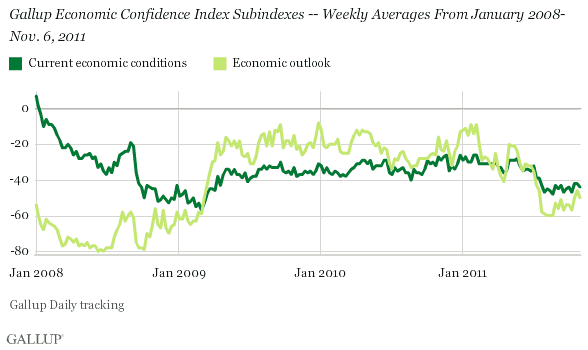
Monthly Confidence Yet to Recover From Summer Slump
Americans' sour economic mood since the summer is also evident in Gallup's Economic Confidence Index monthly averages. Economic confidence was -49 during October, similar to the -50 in September. It has been at these low levels since its downward spiral over the summer -- from -34 in June to -42 in July and to -52 in August. Confidence had previously averaged -26 in May, one of the best monthly readings since Gallup initiated daily measurement of economic confidence in January 2008. Not since the Wall Street financial crisis in late 2008 through early 2009 has monthly confidence descended as low as it has been since August.
These monthly averages are based on interviews with approximately 15,000 national adults conducted as part of Gallup Daily tracking.
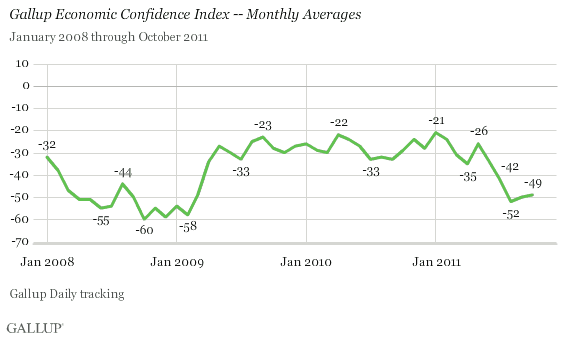
Confidence in October was uniformly negative across the country, with the Index ranging from -46 in the Midwest to -51 in the East. It was also similar across major income groups. Confidence was highest among adults aged 18 to 29, but significantly more negative among those 30 to 49 and more negative still among those 50 and older.
Confidence was markedly higher among Democrats than among either independents or Republicans, highlighting the subjective nature of confidence in the economy relative to politics. With a Democrat in the White House, rank-and-file Democrats show more satisfaction with a number of aspects of the country, including the economy.
Older Americans' economic confidence improved slightly between September and October, as did that of Republicans, residents of the Midwest, and upper-middle-income earners (those making between $60,000 and $89,999 per year), while the index was steady among other groups.
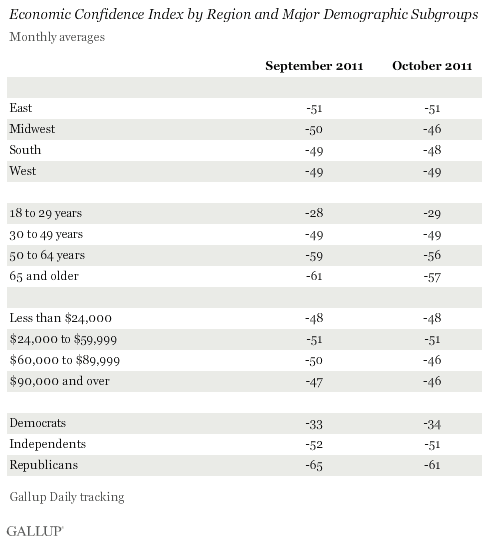
Bottom Line
Americans' economic confidence remains depressed relative to the less negative ratings seen over the past two years; however, the three most recent weekly averages tie or exceed the highest Gallup has recorded since Americans fell into an economic funk in late July. This is also the first time since July Gallup has found confidence exceeding -50 for at least two consecutive weeks. Clearly, a positive shift is underway, albeit slight, and positive only in the sense that it is improved over the very low confidence readings measured in the summer and early fall.
Americans' economic outlook -- the net percentage saying the economy is improving rather than getting worse -- may be the key indicator to watch. As long as that component of the index remains lower than the current conditions component, confidence may remain low. When optimism overtakes perceptions of current conditions -- as it did near the start of 2009 -- overall confidence may rebound.
Survey Methods
Results are based on telephone interviews conducted as part of Gallup Daily tracking Oct. 31-Nov. 6, 2011, with a random sample of 2,974 adults, aged 18 and older, living in all 50 U.S. states and the District of Columbia.
For results based on the total sample of national adults, one can say with 95% confidence that the maximum margin of sampling error is ±2 percentage points.
Interviews are conducted with respondents on landline telephones and cellular phones, with interviews conducted in Spanish for respondents who are primarily Spanish-speaking. Each sample includes a minimum quota of 400 cell phone respondents and 600 landline respondents per 1,000 national adults, with additional minimum quotas among landline respondents by region. Landline telephone numbers are chosen at random among listed telephone numbers. Cell phone numbers are selected using random-digit-dial methods. Landline respondents are chosen at random within each household on the basis of which member had the most recent birthday.
Samples are weighted by gender, age, race, Hispanic ethnicity, education, region, adults in the household, and phone status (cell phone only/landline only/both, cell phone mostly, and having an unlisted landline number). Demographic weighting targets are based on the March 2010 Current Population Survey figures for the aged 18 and older non-institutionalized population living in U.S. telephone households. All reported margins of sampling error include the computed design effects for weighting and sample design.
The questions reported here were asked of a random half-sample of respondents for six nights on the Gallup Daily tracking survey. (There was no interviewing Oct. 31, 2011.)
In addition to sampling error, question wording and practical difficulties in conducting surveys can introduce error or bias into the findings of public opinion polls.
For more details on Gallup's polling methodology, visit www.gallup.com.
